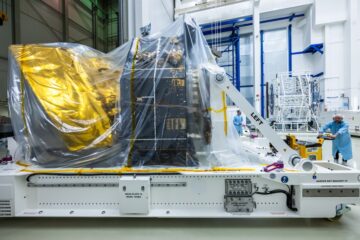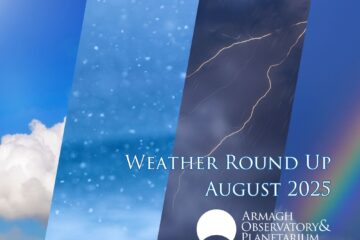We live in a galaxy – a star city with several hundred billion residents. Moreover, we know our Milky Way is a spiral galaxy, with prominent arms of bright young stars that spiral outwards from a central bar that is dominated by old stars. These arms are so prominent as they are where the most massive stars are found. Massive stars have short but dramatic lives. Their youthful vigour means they shine brightly. A star ten times as massive as the Sun shines with an intensity a thousand times greater. The spiral arms thus dominate the appearance of a galaxy when seen from the outside.

A recent sketch of how our Galaxy might look like if viewed from outside, based on interpretation of infrared measurements made with NASA’s Spitzer Space Telescope. Two principal arms (Scutum-Centaurus and Perseus) wrap off the ends of a central bar of stars. Two minor arms (Norma and Sagittarius) are located between the major arms. The Sun lies near a smaller, partial arm known as the Orion Arm, lying between the Sagittarius and Perseus arms. (Image credit: NASA/JPL-Caltech/R. Hurt)
Spiral arms are home to much more than just the brightest stars, however. They are the cauldron for a galactic ecosystem. Driven by flows of energy emanating from stars, a continuous cycle of matter flows backs and forth between the stars and the gas of the interstellar medium.
Spread along the bright spiral arms can be seen prominent dark lanes, clouds of molecular gas and dust which obscure the visible light. Inside these clouds are often found nurseries of infant stars. They are born when gas collapses, under the weight of its own gravity, inside these natal clouds. When their cores get hot and dense enough to start generating nuclear energy from the fusion of protons we say a star is born.

The beautiful spiral galaxy NGC 2997, as imaged by David Malin with the Anglo Australian Telescope. Our own Galaxy would look something like this if it could be viewed from outside. The spiral arms are lit up by the extraordinary luminous young massive stars that are born within the dark clouds of molecular gas that lie along the arms.
(Image credit: ©Australian Astronomical Observatory. www.aao.gov.au)
Particles then stream from their surfaces in stellar winds, enriched in elements produced by nucleosynthesis. The winds sweep up the interstellar gas, which gets compressed and eventually turns into molecular clouds, where star formation can begin once again, so continuing the star-gas cycle. A cycle that has driven the evolution of our Galaxy for the last ten billion years.
How do we know that we live in a spiral galaxy, however, where such an ecosystem plays out? If you look at the sky at night you will see a field of stars, but no spiral arms will be evident in their distribution. If you are lucky enough to see a truly dark sky, however, away from any lights and without the Moon, you will be able to discern a band of stars running across it. This is our Milky Way. Look more closely and dark patches will be seen in the band, apparent voids in space without stars. Today we know that the band is our galaxy, and the voids are clouds of molecular gas and dust where new stars are being formed.

An image of the Milky Way from Northern Ireland showing the dark patches of molecular clouds. (Image credit: Colin Johnston/Armagh Planetarium)
This interpretation – of a spiral galaxy with active star formation within it – is not obvious. When William Herschel (the discover of Uranus) produced the first map of the Galaxy in 1784, from his 40-foot telescope¹ in Slough, west of London (the most unlikely place to now envisage building a telescope!) he came to a different conclusion. By counting the relative numbers of stars he could see with his telescope along different directions in the sky, he produced the map shown below. The “Milky Way” is prominent as the bright band, with relatively few stars found outside it. Some directions in the band do have more stars, and the dark patches that can be seen in it are represented as sightlines with fewer stars.

William Herschel and his first map of the Galaxy, drawn in 1784. The dots represent the relative number of stars seen along each direction. The position of Sun (and ourselves) is represented by the larger dot near the centre. (Image credits: Herschel image: public domain (via Wikimedia.org)/Galactic map from “On the Construction of the Heavens. By William Herschel, Esq. FRS., reproduced with permission)
As described by Herschel “from this figure however, which I hope is not a very inaccurate one, we may see that our nebula, as we observed before, …. has a very extensive, branching, compound congeries of many millions of stars”. A prosaic description – congeries of stars – but unfortunately one that is quite wrong! This is most clearly evident in where Herschel placed the Sun in the map, near to the centre of the Galaxy. Today we know that the galactic centre lies about 25 000 light years away, in the direction of the constellation Sagittarius.
In the visible spectrum we can see no further away from us than about 3 000 light years in any direction along the galactic plane. The reason is because of those clouds of molecules. Dust inside them blocks the light. Going to longer wavelengths, such as the infrared, allows one to peer through the clouds and see the full extent of the Galaxy beyond. However in Herschel’s day the concept of interstellar dust was unknown. Indeed, even infrared radiation was another discovery of Herschel’s, made when he noticed the increase in temperature of a thermometer that was placed just beyond the red end of the spectrum of light from the Sun, after being spread by out by a prism. There was no possibility of measuring such radiation from the stars.
Even the very concept of what a “galaxy” was different in Hershel’s day to now. Then it was considered as the entirety of the cosmos, not as an “island universe” of stars – one of countless billions – that we understand today. However that tale, about the size scale of the Universe, a tale which shaped much of 20th century astronomy, is another story.

The Earl of Rosse’s sketch of the Whirlpool Galaxy (Messier M51), based on visual observations made using the Leviathan in 1845. It reveals the existence of spiral structure for the first time, seen in some kinds of nebulae.
A key event in the tale, though, took place in Ireland in the 19th century and is also central to our story here. The Earl of Rosse built the “Leviathan” in Parsonstown (now Birr) in County Offaly – a 72 inch telescope (1.8m diameter) that was to be the largest in the world for over 50 years. The most famous discovery he made with the Leviathan is of the spiral nebulae, in particular in the object Messier 51, now more commonly known as the Whirlpool Galaxy² . The spiral structure in this sketch of the nebula is obvious. However, since it was not then possible for Rosse to resolve this structure into individual stars, the interpretation of the spirals was not clear. The concept of another “galaxy” as an “island universe” would have to wait nearly a century.
The first “map” of our Galaxy that showed a spiral structure came before then, however, in 1900. It was drawn by the Dutch astronomer Cornelius Easton. He took his inspiration from the spiral nebulae found with the Leviathan, and extended upon Herschel’s method of star counts. He also took advantage of the first comprehensive maps of the southern sky that had recently been made. These showed that the brightest concentrations of stars lay in the south. Easton further interpreted the dark lanes seen in the Milky Way as rifts between collections of stars.

The Dutch astronomer Cornelius Easton’s map of the Galaxy, drawn in 1900, and showing for the first time a spiral structure. As published in a paper in the Astrophysical Journal entitled “A new theory of the Milky Way” (1900, ApJ, v12, p136).
Putting all these facets together, Easton produced a map of the Galaxy displaying spiral structure (see Figure above). He stated “I wish to insist upon the fact that the figure does not pretend to give an even approximate representation of the Milky Way, seen from a point in space situated on its axis. It only indicates in a general way how the stellar accumulations of the Milky Way might be distributed so as to produce the galactic phenomenon, in its general structure and its principal details, as we observe it.”

The nebula Messier 74 in Piscium and its prominent spiral structure, as sketched by Easton. This appearance helped suggest to him the form of the Milky Way.
Easton’s map does show the Sun well removed from the centre of the Galaxy, as well as a clear spiral structure. However his admission that his map does not pretend to even give an approximate representation of the Milky Way is also apt. For instance, he placed the centre of the Galaxy in the direction of Cygnus, not Sagittarius where we now know it to be. The spiral structure also does not remotely resemble what we understand today as the form and position of the spiral arms. The problem was that, in 1900, it was neither possible to see the full extent of the Galaxy, nor was it possible to estimate the distances to objects found with the telescopes of the day. These advances required the invention of radio astronomy, and that occurred five decades later.
Part two of this article will discuss how the invention of radio astronomy allowed the measurement of the atomic hydrogen line at a wavelength of 21cm. This in turn revealed the extent of the Galaxy and resulted in the first “accurate” maps of the spiral arms. Most recently, high frequency radio astronomy – at millimetre wavelengths – has made possible measurements of the molecular clouds – the dark clouds – which lie at the heart of the spiral arms. The latest survey underway of the molecular gas is taking place with the Mopra Telescope in Australia. This story will be told in the concluding part of this article.
Footnotes
- The 40-foot refers to the focal length of the telescope, and not the diameter of the lens – a rather different criterion to the way we now rate the performance of telescopes.
- It is also catalogued as NGC 5194 in the “New General Catalogue”, published by Dreyer in 1888 based on measurements made at Armagh Observatory. The NGC catalogue became the principal source book used by astronomers studying other galaxies for much of the 20th Century.
Article by Michael G. Burton, Director of Teaching in the School of Physics at the University of New South Wales. Director and CEO of Armagh Observatory and Planetarium (Commencing 1 August 2016)





2 Comments
Explorers of the Galaxy (Part 3) The Galaxy in Millimetre-Waves | Astronotes · June 17, 2016 at 10:52
[…] One of this series can be found at this link and Part Two is at this […]
Explorers of the Galaxy (Part 2): The Radio Galaxy | Astronotes · May 17, 2016 at 17:30
[…] the end of part one of this article we left our galactic explorers uncovering the first hints of the existence of spiral structure […]